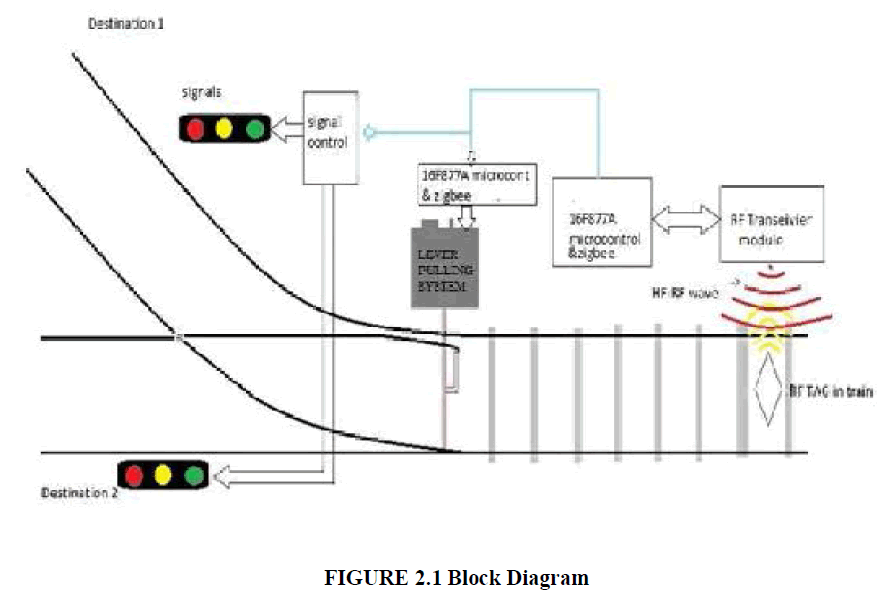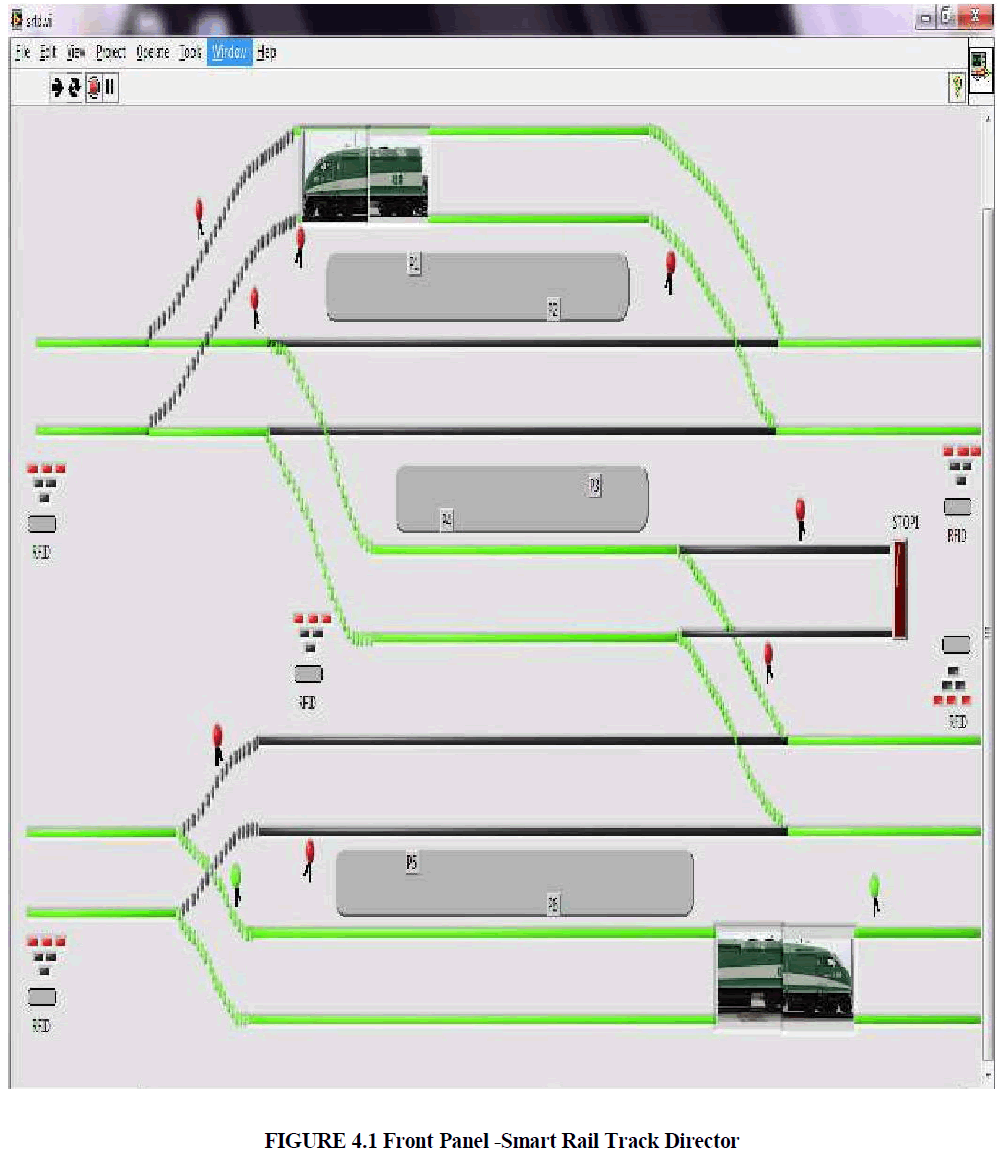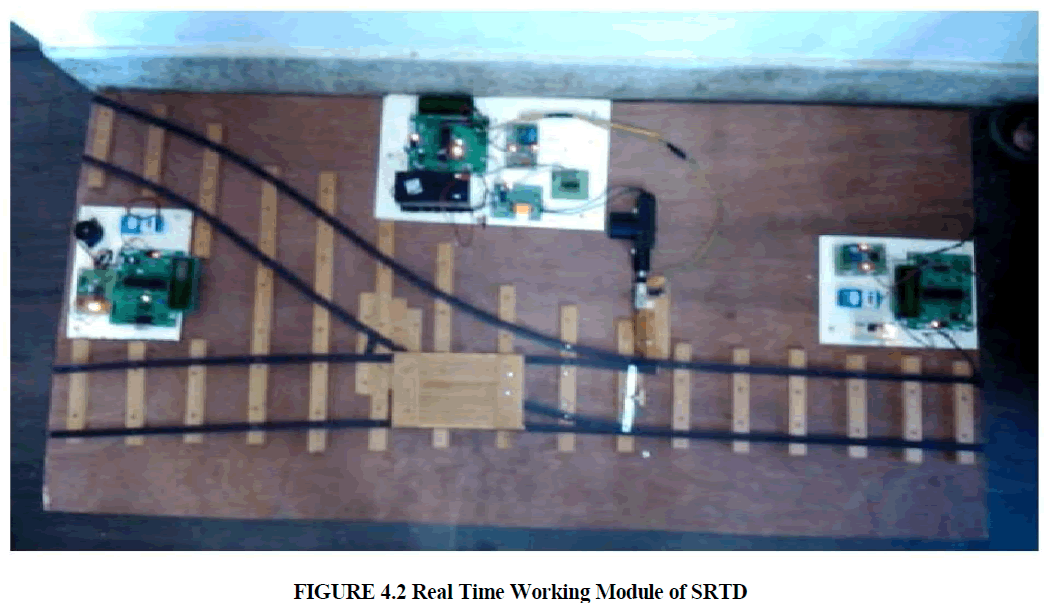ISSN ONLINE(2320-9801) PRINT (2320-9798)
ISSN ONLINE(2320-9801) PRINT (2320-9798)
P.Santhini1, B.Sahaya Jenila2, D.Srimathi3, M.Malarvizhi4, S.Ashvini5
|
| Related article at Pubmed, Scholar Google |
Visit for more related articles at International Journal of Innovative Research in Computer and Communication Engineering
The second largest in Rail network is our nation, India. The Railways is a complex network that they cover every nook and corner of the place. The trains run over the parallel tracks that guide them to a desired destination. This destination of each train is changed or diverted to link the different routes by manually operated electromagnetic systems and the mechanical lever pulling systems. These manual operated systems are subjected to fail on behalf of many basic reasons such as, human error, some problem in the diverting system, the mechanical lever system may get jammed and so on. These simple reasons lead to major disastrous accidents, collisions, which would destroy life and properties to greater extent. So it is very important to control these diverting systems in safe and in better way to avoid accidents. The best way of suppressing such accidents is by implementing automatic system of track changing. This system uses Radio Frequency Identification (RFID) for such intellectual control. This RFID system senses the upcoming trains at a particular distance before the turnouts and actuates the track diverting systems completely by automation.
Keywords |
| Radio Frequency Identification (RFID), Track changing. |
INTRODUCTION |
| The second largest in Rail network is our nation, India. The Railways is a complex network that they cover every nook and corner of the place. The trains run over the parallel tracks that guide them to a desired destination. This destination of each train is changed or diverted to link the different routes by manually operated electromagnetic systems and the mechanical lever pulling systems. These manual operated systems are subjected to fail on behalf of many basic reasons such as, human error, some problem in the diverting system, the mechanical lever system may get jammed and so on. These simple reasons lead to major disastrous accidents, collisions, which would destroy life and properties to greater extent. So it is very important to control these diverting systems in safe and in better way to avoid accidents. |
| The best way of suppressing such accidents is by implementing automatic system of track changing. This system uses Radio Frequency Identification (RFID) for such intellectual control. This RFID system senses the upcoming trains at a particular distance before the turnouts and actuates the track diverting systems completely by automation. |
| Automation of this system is implemented by RFID (Radio Frequency Identification) technology. When the train approaches a turn out or loops, just before a kilo meter the train will be sensed on the basis of the train's number or some unique code which is predefined in a chip called RF tag fixed to the train. When train crosses the RF transceiver system located near the track before a km from the turnout, the radio frequency wave that is transmitted continuously polarizes the tag and receives a response wave that has the information about the train. This information is fed up to the micro controller interfacing system and monitored by the software, which is already programmed, which takes a prompt decision and controls the track diversion. The control system then controls the lever pulling system of the track changing mechanism. So this system controls automatically the route of the trains by directing them to right path to their destination. |
II. RELATED WORK |
| A railway track switching system has been designed to detect the train path and to avoid the train collision. Here a microcontroller is used to reduce the complexity and cost. [1] IR sensor is used to detect the train’s entrance. The signal which is from IR sensor will send it to the centre room. It will processed by software and the corresponding signal will send it to the motor switching unit, in order to change the track.[2] RFID tag is used to stop the train from station to station. RFID tag is used to sense the train reaches which stop and it can be processed and send it to the display by using microcontroller. Automatic place announcement has been done by using voice chip Integrated Chip. RFID tag which is encoded with station name is fitted in to the railway stations. Whenever the train reaches the station microcontroller which is present in the train receives the signal from RFID tag[4]. |
| To avoid the collision of trains WiMAX is used to get the speed, location the train which is having WiMAX connection with laptop and it also can get the speed and location of the other trains[5]. Automatic railway gate control is done by using sensor and microcontroller. Sensor is placed at a certain distance from the gate. The signal from the sensor will provide the signal to the gate to close the gate automatically. Also an indicator light has been provided to alert the motorist that the train approaches[6]. |
| It will check whether the station name which is present in the tag and coded in controller is matched. If it matches the speaker which is present in the train will announce the station name also announces the time to leave the train from station.[10]IR sensor is used for safety purpose, in order to detect the fire and send these signal to the controller. These signals will enable the buzzer to indicate the fire alarming |
III. PROPOSED WORK |
| Automation of this system is implemented by RFID (Radio Frequency Identification) technology. When the train approaches a turn out or loops, just before a kilo-meter the train will be sensed on the basis of the train's number or some unique code which is predefined in a chip called RF tag fixed to the train. When train crosses the RF transceiver system located near the track before a km from the turnout, the radio frequency wave that is transmitted continuously polarizes the tag and receives a response wave that has the information about the train. This information is fed up to the micro controller interfacing system and monitored by the software, which is already programmed, which takes a prompt decision and controls the track diversion. The control system then controls the lever pulling system of the track changing mechanism. So this system controls automatically the route of the trains by directing them to right path to their destination. |
A.PIC operation and characteristics |
| PIC is a family of modified Harvard architecture microcontrollers made by Microchip Technology, originally developed by General Instrument's Micro- electronics Division. The name PIC initially referred to "Peripheral Interface Controller". PICs are popular with both industrial developers and hobbyists alike due to their low cost, wide availability, large user base, extensive collection of application notes, availability of low cost or free development tools, and serial programming capability. Microchip Technology, originally developed by General Instrument's Microcontroller Division. |
| ïÃâ÷ Operating speed: 20 MHz, 200 ns instruction cycle |
| ïÃâ÷ Operating voltage: 4.0-5.5V |
| ïÃâ÷ Industrial temperature range (-40° to +85°C) |
| ïÃâ÷ 15 Interrupt Sources |
| ïÃâ÷ 35 single-word instructions |
| ïÃâ÷ All single-cycle instructions except for program branches (two-cycle) |
| ïÃâ÷ Flash Memory: 14.3 Kbytes (8192 words) |
| ïÃâ÷ Data SRAM: 368 bytes |
| ïÃâ÷ Data EEPROM: 256 bytes |
| ïÃâ÷ Self-reprogrammable under software control |
| ïÃâ÷ In-Circuit Serial Programming via two pins (5V) |
| ïÃâ÷ Watchdog Timer with on-chip RC oscillator |
| ïÃâ÷ Programmable code protection |
| ïÃâ÷ Power-saving Sleep mode |
| RFID is Radio Frequency Identification Device. It is a fast, affordable and automatic identification technology that uses radio frequency (RF) to transfer data between a RFID reader and a RFID tag. Usually the RFID circuit is a single solidstate memory chip, but could also be designed where several electronic components together are used to form an integrated circuit design. In other words, RFID is a means of capturing data about an object without having a human to read it. It holds a small a mo u n t o f u n i q u e d a t a - a s e r i a l n u m b e r o r o t h e r u n i q u e a t t r i b u t e o f t h e i t e m .T h e d a t a c a n b e r e a d f r o m a d i s t a n c e - n o c o n t a c t o r e v e n l i n e o f s i g ht necessary RFID technology uses RFJD tags, which is a small object, such as an adhesive sticker, that can be attached to or incorporated into a product. RFID tags contain antennas to enable them to receive and respond to radio-frequency queries from an RFID transceiver. |
C. ZigBee |
| ZigBee is the name of a specification for a suite of high level communication protocols using small, low-power digital radios based on the IEEE 802.15.4standard for wireless personal area networks (WPANs). ZigBee is targeted at radiofrequency (RF) applications which require a low data rate, long battery life, and secure networking. ZigBee and IEEE 802.15.4 are standards-based protocols that provide the network infrastructure required for wireless sensor network applications. 802.15.4 defines the physical and MAC layers, and ZigBee defines the network and application layers. ZigBee operates in the industrial, scientific and medical (ISM) radio bands; 868 MHz in Europe, 915 MHz in the USA and Australia, and 2.4 GHz in most jurisdictions worldwide |
D. SRTD Operation |
| This gives the detailed operation of SRTD(Smart Rail Track Director). The RFID tags are present fixed on the railway tracks one kilometer before the track changer. A RFID transceiver module is present fixed adjacent to the RFID tags but outside the track. In case of train crossing the track the RF signals are transmitted and it is received by the transceiver. The signal transmission is done using ZigBee protocol. The PIC 16F877A receives the signal, it is connected with a lever pulling system and the signal controller. If both the RFID tags that are connected with the same track generates RF signal then the microcontroller takes the control over the system and it changes the track and the signal for the passing of rail accordingly. Fig 2.1 shows the overall operation that is taken place in the Smart Rail Track Director. |
 |
IV. SIMULATION RESULTS |
| The software used for simulation is LABview. Fig 4.1 shows the simulation output for the front panel operation that are done in a moving train by using the Smart rail track director. The automatic change of the tracks is done automatically without any manual operations. |
 |
| This is a real time working module for Smart Rail Track Director is shown in Fig 4.2. This arrangement consists of a RFID tag and reader, PIC Microcontrollers, ZIGBEE's. The ultimate target is to change the track by automatic control by using the embedded c program which is fed to the micro controller. The RFID reader is placed near the track, about 1 km from the turnouts. The RFID reader is used to read the information in the tag which is placed in the train's first carriage and generate RF signals and these RF signals are converted into electric signals by using RC OSCILLATOR. These electric signals are used to transfer the information through ZIGBEE's to another micro controller .The micro controller will control the track change by pulling method using relay gun. The station master can able to know, when the corresponding track for the corresponding train is not opened from in his room itself due to the wireless communication by ZIGBEE. |
 |
V. CONCLUSION AND FUTURE WORK |
| Automation replaces human's activity. They work as instructed by humans perfectly than us. So this automation in track changing, aids the environment and public safe by avoiding misleading. The use of RFID system is very efficient and important factor is their cheap availability. Also they require minimum infrastructure maintenance and this helps an easy development of the infrastructure. The RFID system provides a safe and a secure system to control the track switching system. This automation of the track switching system is very important as it can completely eradicate the rail accidents in the nearing future. If implemented, Smart Rail Track Director will play a key role for safety and advancement in technique for Railways. |
| In future, this system can be implemented by using GPRS. Since GPRS plays a major role in developed countries. So this system can be more advance and fast response by using GPRS. GPRS is the most advanced communication. GPRS plays a vital role in fast transmission as well as clear response by using spectrum analysis .So the GRPS will be used in the future for the implementation of our system. |
References |
|